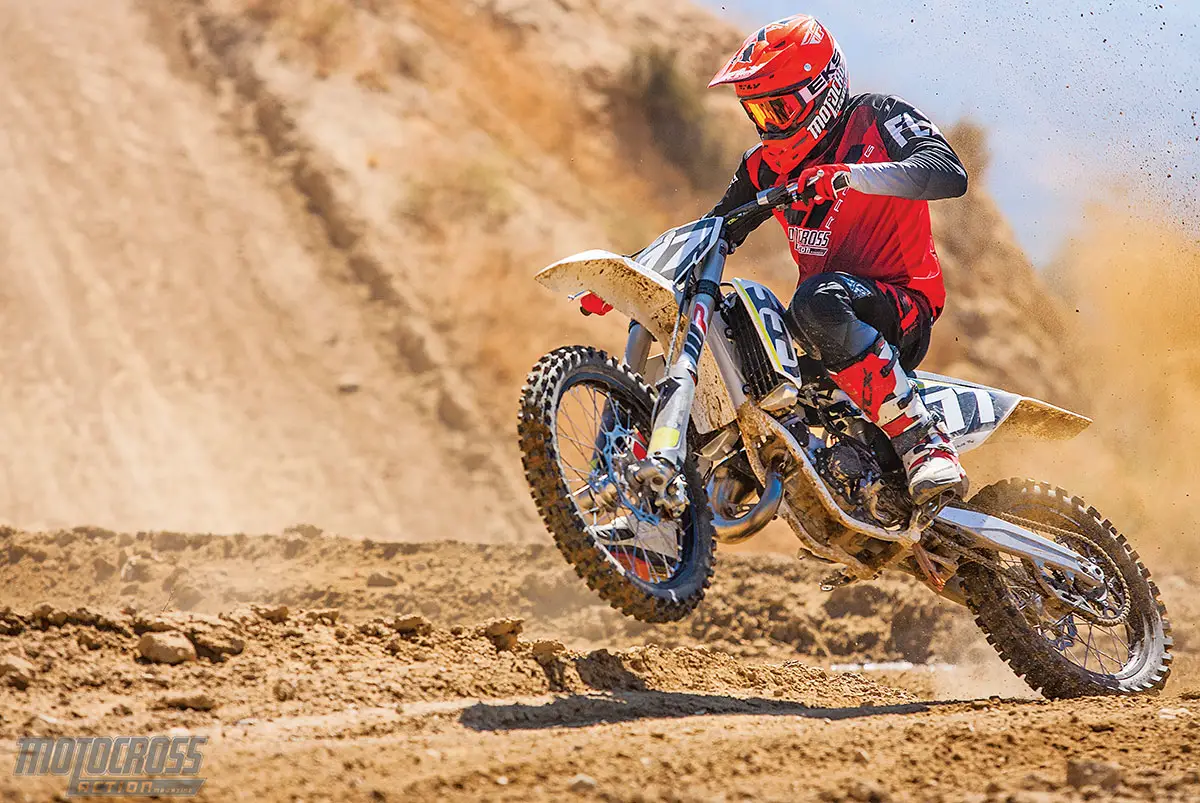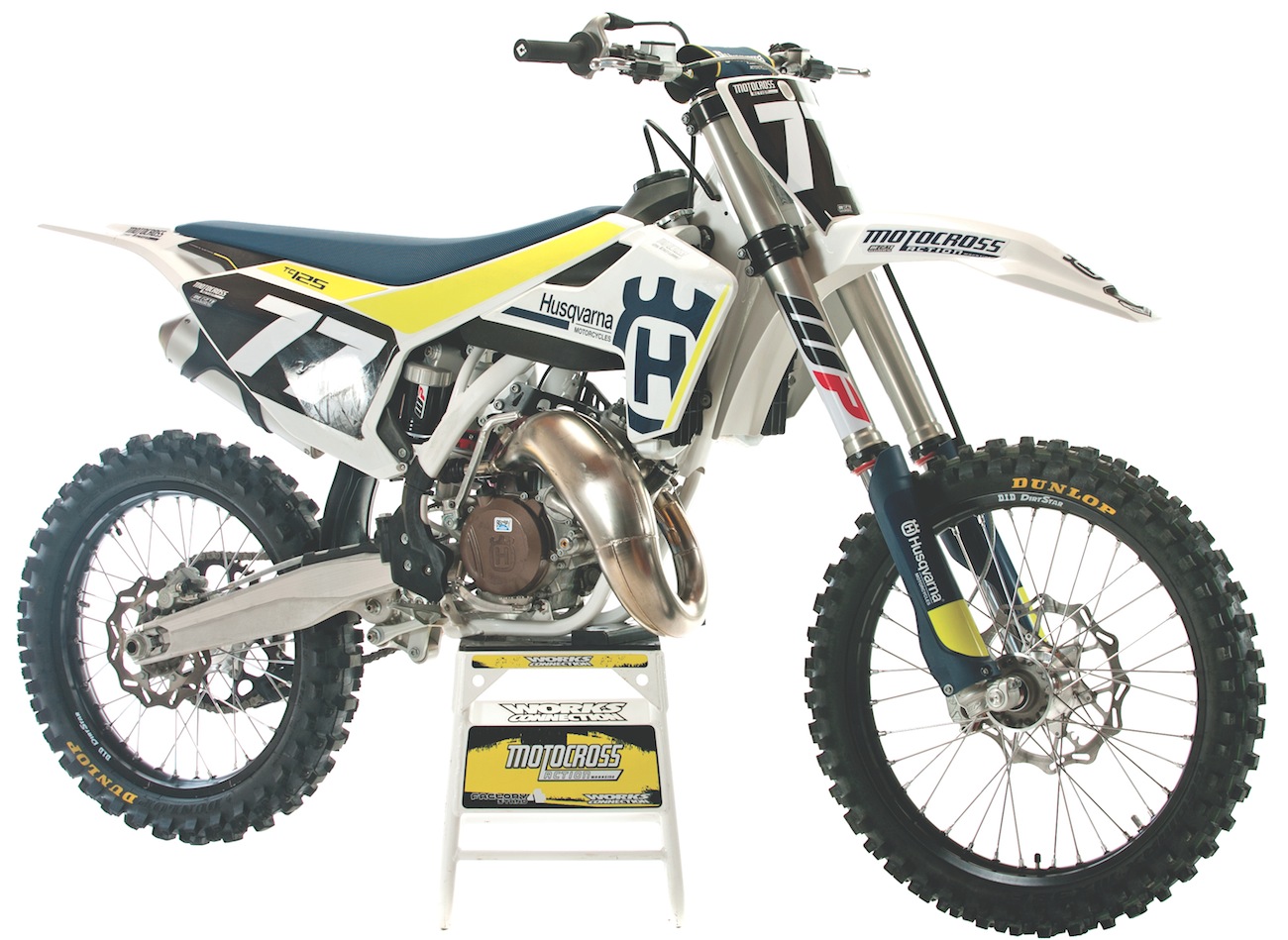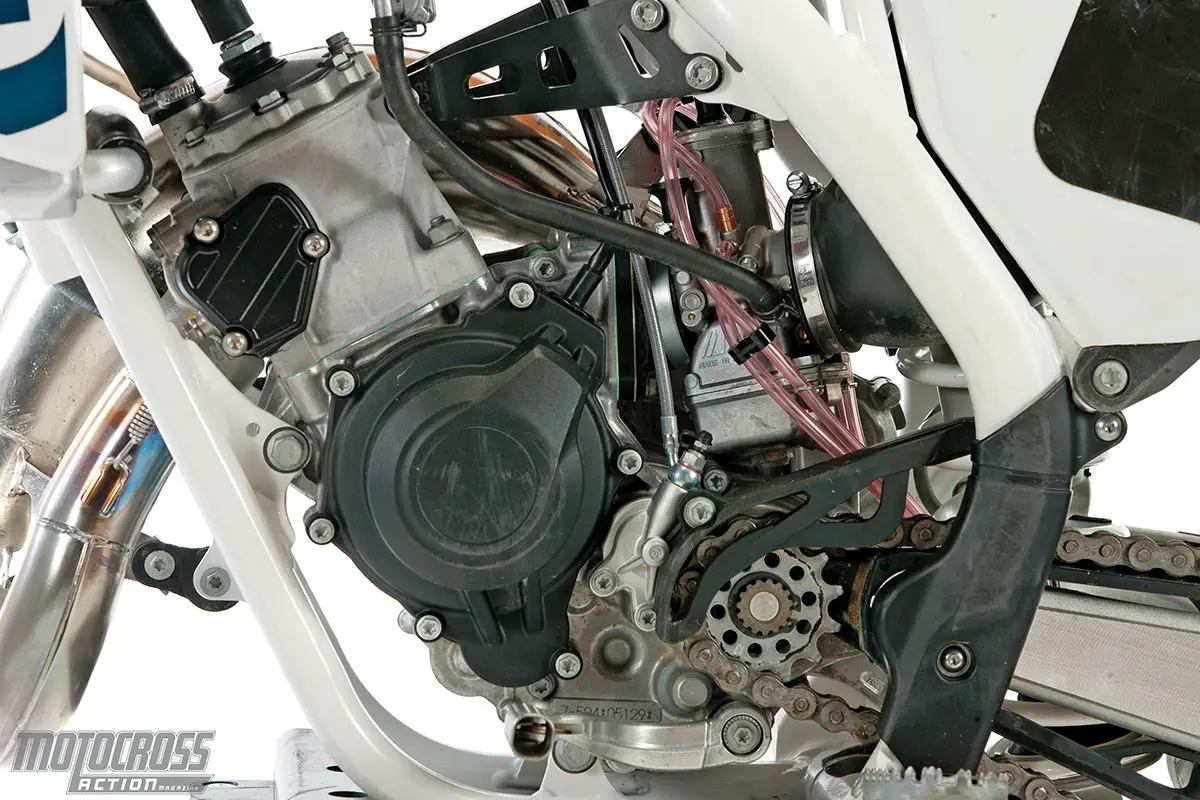MXA RACE TEST: 2017 HUSQVARNA TC125 TWO-STROKE: LITTLE BROTHER GROWS UP
Click on images to enlarge

Q: FIRST AND FOREMOST, IS THE 2017 HUSQVARNA TC125 BETTER THAN THE 2016 TC125?
A: Yes. But give a giant share of the credit to the new WP 48mm AER air forks. The other seven changes to the 2017 TC125 enhance the bike, but are small potatoes compared to the contribution of WP’s radically new air fork.
Q: WHAT HAS CHANGED AT HUSKY OVER THE LAST SEVEN YEARS?
A: In the last decade the Husqvarna brand has changed ownership three times. In 2007 BMW purchased the historic brand from MV Agusta, but BMW had serious issues finding customers and soon racked up a reported $250 million in losses. When it was time for BMW to offload the company in 2013, KTM’s Stefan Pierer was there to take it off BMW’s hands for pennies on the dollar.
The history of 125cc Husqvarna two-strokes would never make a motocross highlight reel—at least until Stefan Pierer moved the brand to Austria. We won’t bore you with the doldrum years of Husky 125 development in the early 2000s, but we will give you a quick overview of what has changed in the last seven years.
 The big changes for 2017 are the WP AER air forks, more rigid top clamp, longer brake pedal, TMX 38mm carb and ODI lock-on grips.
The big changes for 2017 are the WP AER air forks, more rigid top clamp, longer brake pedal, TMX 38mm carb and ODI lock-on grips.
What was new on the 2011 Husky CR125? The Husqvarna 125, then known as the CR125, got a modified frame with a streamlined engine cradle, new motor mounts and matching cylinder-head fittings. Also upgraded were the water-resistant air-filter housing and almost-contemporary 48mm Kayaba forks. Yes, the same Kayaba forks off the YZ125, just a dated version with different valving.
What was new on the 2012 Husky CR125? The best thing Husky did in 2012 was throw in a 144cc top-end kit with every CR125 they sold. The kit was a plug-and-play assembly that livened up the pony power. This bumped the displacement from 124.8cc to 144cc (via an extra 4mm of bore). Additionally, Husqvarna reinforced the steering-head area of the chassis with gussets and switched to a black frame, silver Excel rims and new graphics.
What was new on the 2013 Husky CR125? With sales in the dumps, Husky didn’t have the R&D money to invest in a new engine or chassis. It should be noted that the old-school CR125 engine pumped out a reasonable 35 horsepower at peak. That’s not far from a YZ125 powerplant. It is true that the powerband was short and the bike was hard to ride, but in the right hands this mill could sing the high notes all day long. The minor changes for 2013 were black grips, a new handlebar pad and graphics.
What was new on the 2014 Husky TC125? In 2014 things started to get interesting. Stefan Pierer had purchased Husqvarna in 2013 but didn’t have time to come out with a new model that year. For a time, there was a lot of mystery surrounding what his intentions were. It was obvious something big had to happen for the Swedish/Italian/Malaysian/German/Austrian brand to make a profit. Without having to spend tons of money on R&D, Stefan took the proven engine and chassis of the 125SX and covered it with Husky salad dressing. So, what changes were made? There were no left-over Husqvarna parts on the 2014 Husky TC125. The bike was literally a KTM 125SX clone with different-shaped plastic, a closed-off airbox (to make the engine delivery unique), and a few other odds and ends. Unfortunately, the TC125 didn’t make it over the pond in 2014. Only the FC450, TC250 and FC250 were imported to the USA.
What was new on the 2015 Husky TC125? The entire fleet of 2015 Husqvarnas got a shopping list of updates. Most significant were the WP 4CS forks. We didn’t love them, but we found ways to live with them. The shock linkage was lengthened 2.5mm, making for a less progressive curve. The sealed airbox was given some breathing room, although not enough to make a significant difference. The updated seat-cover material was like a slip-and-slide. Other small changes were the Dunlop MX52 tires, Neken bars and smaller fork guards (we still miss the old-style wraparound guards).
What was new on the 2016 Husky TC125? For 2016 both KTM and Husky did a complete overhaul of its 125s. The new, lighter engine pumped out more power across the entire spread. The updated chassis allowed for improved handling traits, and the WP components had a flexible and comfortable feel. Only a handful of parts were used from the previous model. Overall, the 2016 TC125 was lighter, faster, better suspended and a blast to ride. The matter in question was still the forks. Although the 4CS units handled better under the new chassis, we still didn’t like them. They were either too soft or too stiff. There was no middle ground.
 The 2017 Husqvarna TC125 is the twin brother of the KTM 125SX. These two 125cc machines are the fastest small-bore engines to hit the showroom floor in history.
The 2017 Husqvarna TC125 is the twin brother of the KTM 125SX. These two 125cc machines are the fastest small-bore engines to hit the showroom floor in history.
Q: WHAT’S NEW ON THE 2017 HUSKY TC125?
A: Husky finally found a solution for the number-one complaint that every Husky owner has made each and every year. Even though the Husky and KTM 125s are the lightest and most powerful 125s on the market, their Achilles heel has always been the WP forks. Sadly for the 125SX and TC125, 10-year-old Kayaba SSS forks blew the WP 4CS components out of the water. There was no comparison. Husky was at a standstill if they couldn’t get better forks. Finally, the curse of WP has been removed from the Husky and KTM family tree! No, the engineers didn’t switch to Kayaba SSS forks, but they got the all-new WP 48mm AER air forks to work in harmony with the Husky chassis. The forks are plush and firm at the same time, and they get bonus points for being the simplest air forks to live with. The 2017 KTMs and Huskys are the first complete packages to hit the market in decades.
Other changes made to the 2017 TC125 are the 10mm-longer brake pedal, glazed-over rear brake pads, Mikuni TMX 38mm carburetor (we miss the Keihin, but we will get to that later), bridge-style top bar-mount clamp, ODI lock-on grips and Dunlop MX3S tires.
Q: HOW MUCH DOES THE 2017 TC125 COST?
A: We are happy that two-strokes are still within reach of blue-collared workers. These smokers give young riders a chance to afford the joys of the greatest sport in the world. With each passing year motocross has become more of a rich man’s sport. There’s a reason the motorcycle industry sold 1,000,000 dirt bikes per year back in the 1970s—and it wasn’t because they cost $9000. They were affordable. It’s no surprise that those phenomenal numbers have shrunk by 90 percent, especially considering the ill effect that four-stroke complexity has had on the consumer. Two-strokes are still affordable. Why? Because they have 100 fewer parts in the engine. They are cheaper to build, cheaper to buy and cheaper to maintain. Sadly, we are afraid that electronic fuel injection will skyrocket two-stroke prices in the future. For now, the TC125 costs $6999. The KTM 125SX is $6899, and the dated YZ125 is $6499. Compare that to $7699 for the Yamaha YZ250F or $8499 for the KTM 250SXF.

Q: HOW DOES THE TC125 ENGINE RUN?
A: If you haven’t ridden a new-age KTM or Husky 125cc two-stroke, you will be pleasantly surprised—shocked even! They have broad powerbands that can keep the 250 four-stroke bottom feeders in sight. There is no more abusing the clutch out of corners. The Husky powerplant pumps out 37 horsepower at 195 pounds. The power-to-weight ratio is incredible. The TC125 takes longer to get to the meat of the powerband compared to the KTM 125SX due to its restrictive airbox design. Once there, however, the engine pulls like a scalded cat to the top. Want that peppy KTM bottom end? No problem. Just cut a few holes into the right side of the airbox.
Q: WHAT’S THE ONE THING THAT NEEDS TO BE CHANGED OFF THE SHOWROOM FLOOR?
A: Jetting. We don’t know why KTM decided to switch from Keihin to Mikuni carburetors. What we do know is that it had nothing to do with performance. It was a questionable decision, based on the fact that we have had nothing but jetting issues with the TMX carb. It runs extremely rich. Finding the perfect combo is not a simple task. We found a setting that we could live with in the jetting sidebar. But, if you’re lost and looking for answers, we recommend calling JD Jetting at (360) 350-0557. He sells jet kits for your elevation and weather. The best part is that if you are still having issues, they won’t charge you a dollar extra until they get your bike running optimally. what we ended up doing, which you rad about at the end of theis test, isn’t something that the average rider will do willing—but to a certain extend it did work. Just in case ,we included the basic jets to fix the CRr125 brass.

Q: ARE THE WP AER AIR FORKS REALLY THAT GOOD?
A: In the world of air forks, yes. We have been pleasantly surprised by the simplicity and function of the WP AER air forks. We admit to having some issues with the air forks on the 2016 KTM Factory Editions, but those forks were just the stalking horse for the improved 2017 AER forks. The two forks are not the same. This year’s forks have 1mm-thinner stanchions from the bottom triple clamp down. This, along with the more rigid top clamp, takes away that harsh slap-down sensation and adds flex to the ride. We have to note that although this is the best air fork to date, the Kayaba SSS spring fork is still near and dear to our hearts.
On the TC125, we found the recommended 123 psi was just right for the majority of our riders. Top-level riders went only a few pounds north to keep the forks from diving too low under braking. Every MXA test rider went out on the compression, regardless of the air pressure. This allowed the top of the stroke to soak up small chop better and alleviated the slight harshness of the mid-stroke. Last year’s jarring metal-to-metal hit upon bottoming of the 4CS fork is no more. The WP AER forks have firm resistance at the bottom of the stroke. The fork itself is confidence-inspiring.
Q: WHAT DID WE HATE?
A: The hate list:
(1) Frame color. With the TC125’s puny black frame guards, the white frame is exposed. In just a few rides the white paint starts to wear off.
(2) Airbox. The KTM 125SX has a better powerband than the identical TC125 engine. Why? The TC125’s sealed-off airbox doesn’t allow the Husky to breathe. Don’t be scared to drill holes in the side panels or even remove a section of the right-side airbox to get more excitement in your life.
(3) Spacers. There are spacers in the seat-bolt hole and right-side panel that fall out when you remove either of these two bolts. Shouldered bolts or tolerance-fit spacers would have solved this issue.
(4) Tubes. The stock ultra-thin tubes will spring a leak the first time you hit a rock. We recommend replacing them immediately with STI’s heavy-duty tubes.
(5) Shock-ring collar. With all the high-end parts on this bike, you would think that after multiple years of complaints, Husky and KTM should do something about the cheap plastic shock collar.
(6) Torx bolts. You can’t bleed the forks without a #20 Torx wrench or remove the ODI lock-on grip or right-side panel without a #15. Even the brake and clutch master-cylinder caps are held on with Torx bolts.
Q: WHAT DID WE LIKE?
A: The like list:
(1) Ergonomics. When you swing a leg over the TC125, you feel right at home.
(2) Air filter. Installing an air filter in the TC125 is dummy-proof. It just can’t be messed up, even if you install it backwards, upside down or inside out.
(3) Forks. The WP AER air forks are simple and offer exceptional performance.
(4) Handling. We love this chassis. This bike goes wherever you want it to with ease. It is nimble, light and corners with precision.
(5) Radiator guards. The engineers over at Husky put a lot of effort into designing their radiator guards. The guards don’t just manage airflow; they are also strong enough to serve as radiator braces.
(6) Brakes. Although the rear brake pads are not as touchy as last year, which most MXA test riders liked, they are still the best in the business. If you’re looking for that extra pucker power, you can still buy the old brake pads. The part number is 548-1309-0300.
(7) Engine. This is the best production 125cc engine to hit the market, whether in a KTM or a Husky. The powerband is broad, powerful and, most of all, fun.
Q: WHAT DO WE REALLY THINK?
A: Husqvarna isn’t fooling anyone. It is still just a KTM with a fake mustache and dark sunglasses. We are among the buying public who want these two products to be differentiated from each other. We accept that KTM wants to maximize the economy of scale that comes from already building engines, forks and frames, but nevertheless, we expect a Husqvarna to have something special to build customer loyalty. Still, it is hard to ignore how good the Austrian twin 125cc machines are. We adore the entire package. From the chassis to the plush suspension to the potent powerplant, this is a great machine for anyone getting off a minicycle or for those riders who like to twist the throttle to the stops.
MXA’S HUSQVARNA TC125 SETUP SPECS

This is how we set up our 2017 Husqvarna TC125 for racing. We offer it as a guide to help you find your own sweet spot.
WP AER AIR FORK SETTINGS
First, focus on balancing out the bike for your weight by adjusting the air in the forks. If the forks are diving into the corners, go up a few psi. If they tend to be rigid and push out on the entrance of corners, drop the psi down a few points. For riders between 155 and 170 pounds, we ran 123 psi. Riders 170 to 200 pounds favored 125 psi. Once the pressure was set, all the riders went softer on the compression. The forks have good bottoming resistance, so going softer for a plusher ride is not an issue. For hardcore racing, we recommend this fork setup on the 2017 Husqvarna TC125 (stock settings in parentheses):
Air pressure: 123 psi
Compression: 20 clicks out (12 clicks out)
Rebound: 11 clicks out (12 clicks out)
Fork-leg height: Stock
Notes: The fork spring rate is light because of the target weight of the typical 125/150 rider. If you are heavier, don’t worry; the WP suspension has enough adjustment to accommodate you. Lighter riders can turn the compression clicker out to get the feel they want.
WP SHOCK SETTINGS
The rear shock was in the ballpark for the majority of our testers. For hardcore racing, we recommend this shock setup for the 2017 Husqvarna TC125 (stock specs are in parentheses):
Spring rate: 42 N/m
Race sag: 108mm (110mm)
Hi-compression: 2-1/2 turns out (2 turns out)
Lo-compression: 12 clicks out (15 clicks out)
Rebound: 15 clicks out
Notes: The stock shock settings are in the ballpark. We ran slightly less sag than what Husqvarna recommends (110mm) but more sag than what we ran with the KTM 125SX due to the Husky’s taller seat height.
MIKUNI TMX 38MM JETTING SPECS
Here’s what we ran in our 38mm TMX (stock settings are in parentheses).
Main jet: 480
Pilot: 32 (45)
Needle: 6BFY43-74
Clip: 3rd
Air screw: 1 turn out (1-1/2)
Notes: Husqvarna, via KTM, recommend that TC125 owners run their fuel mixture at 60:1. The MXA test riders balked at this lean mixture, but finally agreed to do it as a test, as long as Husky was with us, and would rebuild our engine if it seized. We cut a hard bargain. Surprise! The Mikuni did run cleaner and could run much closer to stock jetting than when we ran 40:1. Still, Husky isn’t coming to the track with you, so proceed with caution.










Comments are closed.